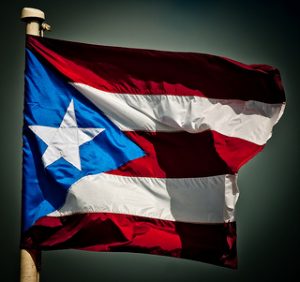Puerto Rico, A Latino 51′st State of the Union?

 By Charles R. Venator-Santiago, Latino Decisions
By Charles R. Venator-Santiago, Latino Decisions
As plebiscitary debates in Scotland and Cataluña continue to grow, the debates over the outcome of the 2012 Puerto Rican plebiscite appear to be waning with the change of government in the island. Notwithstanding, the pro-statehood interpretations of the outcomes of the 2012 plebiscite suggest that Puerto Rico could become the 51st state of the union. This entry follows up on previous posts by contextualizing some of the key debates informing possible Federal responses to the competing interpretations of the results for the 2012 plebiscite.
 United States constitutional history does not provide a clear guide for the admission of new states. The Constitution is silent on the process of admitting new states into the Union. Simply put, Article IV, §3 enumerates Congress power to govern territories (c. 2) and admit new states (c.1), while §4 requires all states to establish a “republican” rather than “democratic” form of government. Moreover, although it is possible to discern some patterns from the legislative histories of the admission of the 37 states integrated into the Union, these patterns were largely a result of the political context of the period in which states were admitted. Likewise the Supreme Court has typically deferred to Congress and has not provided a clear interpretation of the statehood admissions process.
United States constitutional history does not provide a clear guide for the admission of new states. The Constitution is silent on the process of admitting new states into the Union. Simply put, Article IV, §3 enumerates Congress power to govern territories (c. 2) and admit new states (c.1), while §4 requires all states to establish a “republican” rather than “democratic” form of government. Moreover, although it is possible to discern some patterns from the legislative histories of the admission of the 37 states integrated into the Union, these patterns were largely a result of the political context of the period in which states were admitted. Likewise the Supreme Court has typically deferred to Congress and has not provided a clear interpretation of the statehood admissions process.
More importantly, the history of U.S. territorial status plebiscites shed no light on the statehood admissions process. For example, despite popular votes against statehood in seven territories [Maine (1807-74%), Wisconsin (1844-78%), Nebraska (1860-53%), Colorado (1859-55%), Oregon (1856-58%), Washington (1871-70%), and Arizona (1912-84%)], Congress passed statehood annexation laws in each instance. The opposite is also true. Texas stands as the most notable example where a majority of U.S. citizens repeatedly voted in favor of statehood only to be rejected by Congress on several occasions. Notwithstanding, a hermeneutic reading of the overall political history of the statehood admissions processes can provide some useful parameters for a discussion of the potential admission of Puerto Rico as the 51st state of the Union.
Competing interpretations of the 2012 Plebiscite on Puerto Rico’s Political Status can lead to at least three possible outcomes or scenarios. All of these scenarios, however, should be read against the backdrop of the current political climate in Washington, D.C., a climate shaped by ideological and partisan polarization.
Silence and Inaction: The Most Likely Scenario
The most likely outcome of the 2012 plebiscite is that the U.S. government will ignore the pro-statehood interpretation. This interpretation is anchored on three arguments.
The Republic Argument. Federal lawmakers are likely to note that the U.S. is a republic and Congress wields the plenary power to determine what, how, and when a territory joins the Union. The 2012 plebiscite was not a congressionally sanctioned plebiscite and Congress is not bound to the outcomes of a local vote.
The Balance of Power Argument. Following the election of Franklin D. Roosevelt, local elites across the ideological spectrum from both the pro-statehood and autonomic parties aligned themselves with the mainland Democratic Party. Presidential candidates hold primaries in Puerto Rico although the island, like all territories except Washington, D.C., is currently constitutionally barred from participating in the Electoral College. Less than a quarter of local residents participate in presidential primaries, yet almost twice as many vote in the Democratic rather than the Republican Party primaries. In fact, of the 7 living acting and former governors, 5 have campaigned for the Democratic Party, 1 identifies as an independent, and 1 as a member of the Republican Party. In addition, as my colleague Jeff Ladewig has demonstrated, calculations based on the 2010 census establish that 5 congressional seats ( in the states of Texas, California, Washington, Minnesota, and Florida) would likely be reapportioned to incorporate a Puerto Rican state. In sum, the admission of a Puerto Rican state not only entails reapportioning 5 congressional seats, but also admitting a new state that would bring 2 Senators and at least 4 or maybe 5 Representatives who would likely be members of the Democratic Party. Without a counterweight, there is little evidence to suggest that the Republican controlled House of Representatives will entertain admitting a new state that will contribute to tilting the balance of power in Congress in the direction of the Democratic Party.
Procedural Arguments. Two minor, but important arguments suggest that some Federal lawmakers opposed the outcomes of the 2012 plebiscite on procedural grounds. First, during the hearings for the Democracy Act of 2010 (the Federal precursor for the 2012 Puerto Rico plebiscite), Rep. Jason Chaffetz (R-UT) argued that he would not entertain any outcome unless 2/3 of the electorate voted in favor of the winning option. Likewise, Rep. Virginia Foxx (R-NC) argued that the language of the plebiscite was designed to exclude the Commonwealth option and stack the vote in favor of statehood. To this extent, it is possible to argue that Republicans in Congress would reject the pro-statehood interpretation and argue that the language of the plebiscite was confusing and exclusionary.
Presidential Action: Possible Scenarios
Although recent comments by President Obama’s Press Secretary suggest that he has not accepted the pro-statehood interpretation, the President may choose to take an active role without compromising much political capital. The President may encourage Representative José Serrano (D-NY) to re-introduce the Democracy Act of 2010 (which passed the House, but died in the Senate) and authorize a Federally sanctioned plebiscite in Puerto Rico. Alternatively, President Obama could support the current Governor-Elect Alejandro García Padilla’s proposal to hold a Puerto Rican constitutive assembly in 2014 to revisit the status question in a manner more inclusive of all Puerto Rican local political parties and ideologies.
Statehood: The Least Likely Scenarios
As previously noted, there is no set constitutional pathway to statehood. However, a hermeneutic reading of past statehood admissions histories suggests that Puerto Ricans advocating for statehood could invoke at least two precedents.
The Tennessee Plan. First adopted in 1796 by the Tennessee territory (and subsequently invoked by Michigan, Iowa, California, Oregon, Kansas, and Alaska), the Tennessee plan established that territories could simply declare statehood and unilaterally present Congress with two Senators and the respective number of representatives (in this case 5). United States citizens could invoke a popular sovereignty claim to constitutional membership in the fraternity of states and simply demand a seat at the counter.
Enabling Process. Alternatively, Congress could honor the pro-statehood interpretation of the 2012 plebiscite’s outcome and begin the process of statehood admission. At this point Congress could enact a simple territorial incorporation law ascribing a formal territorial status to Puerto Rico (in order to differentiate the island from other unincorporated territories). Federal lawmakers could subsequently enact legislation enabling Puerto Rico to draft a state constitution contingent on the approval of Congress. Assuming a majority of members of Congress approved the Puerto Rican state constitution, the President would sign the law enabling Puerto Rico to become the 51ststate of the Union, making Puerto Rico a Latino/a state.
This article was first published in Latino Decisions.
Charles R. Venator-Santiago is an Assistant Professor in the Department of Political Science and the Institute for Latino/a, Caribbean and Latin American Studies at the University of Connecticut.
[Photo by Ricymar Fine Art Photography]
